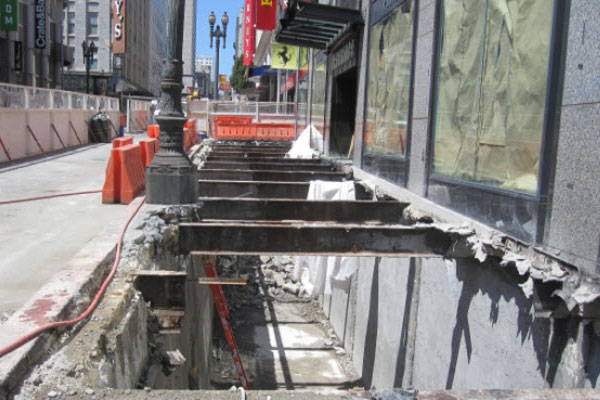
Are you a building owner or property manager of a commercial building listed on the National Register of Historic Places?
Have you ever wondered what would happen if a project in your neighborhood or on your street affected the stability of your building? You may not even realize your building has a stability issue, especially if it’s outside under the sidewalk! Out of sight, out of mind.
If your city’s public works department is working on a street project, it’s very likely your sidewalks will be affected. Sidewalk vaults are often overlooked during the maintenance phase, which could mean costly repairs for you.
What is a sidewalk vault?
Sidewalk vaults are a partial extension of a building’s basement under the adjacent sidewalk. They can extend up to and sometimes beyond the curb under the roadway. Introduced in the 19th century in urban areas, the vaults allowed access to utilities and delivery areas without entering the building.
Common sidewalk construction consisted of a 4″ topping slab or brick pavers on a waterproof membrane on a 4″ to 6″ structural slab spanning between steel or concrete beams or masonry arches. Before electricity, cast-iron and precast panels were fitted with glass lenses to allow daylight to reach otherwise dark vaults. Another common top consisted of 6″ to 8″ granite panels without waterproofing. Curbs were often faced with steel plate to protect them from vehicles parked on or driven over them.
How do sidewalk vaults present potential risk or liability?
Sidewalk vault slabs constructed in the 19th century lacked the drainage and waterproofing details in use today. If waterproofing membranes were used, they were typically poorly installed and/or not easily maintained. They also did not allow for drainage at the membrane level. Decades of slow water migration into the slab resulted in freeze-thaw damage and corrosion of reinforcing and support steel. With the decline in usefulness, sidewalk vaults have been neglected to the point that their structural integrity is in question.
Additionally, in the 19th century sidewalk slabs were built prior to modern building codes and were intended to support pedestrians. Today’s building code sidewalk loading criteria is intended to support parked trucks.
Sidewalk vault degradation is commonly out of sight and out of mind. They are not subject to ordinances similar to those for building facades and fire escapes. Often, the unsafe conditions are discovered by accident or partial collapse thus exposing building owners to tremendous liability and significant cost.
What can you do to protect your property?
Consider hiring a structural engineering firm with expertise in failure analysis and experience in the evaluation of sidewalk vaults to perform a structural condition survey.
The structural engineer should provide a condition assessment report including:
- Findings and recommendations for remedial work
- Methods used to conduct the investigation
- Photographic documentation
- Cost estimates for making recommended repairs, and
- A professional engineering seal, signature, and date
- Depending on the results of the structural survey, the engineer should also provide engineered temporary and/or permanent shoring of sidewalk and basement walls (if needed) to support any surcharge loading requirements identified during the assessment. Temporary shoring is only a short-term alternative (band-aid) to alleviate the most immediate structural concerns, while allowing more time for the development of other permanent solutions
IEI Provides Expert Structural Engineering Analysis
Our engineers are experts in structural engineering failure analysis and have extensive experience with inspecting and analyzing sidewalk vault conditions. We typically recommend a phased approach consisting of a cursory condition assessment followed by other phases that may include closer examination, analysis, or improvements as necessary. In this manner, building owners are able to better control their expenditures, risk, and liability. Contact us today to learn more.
